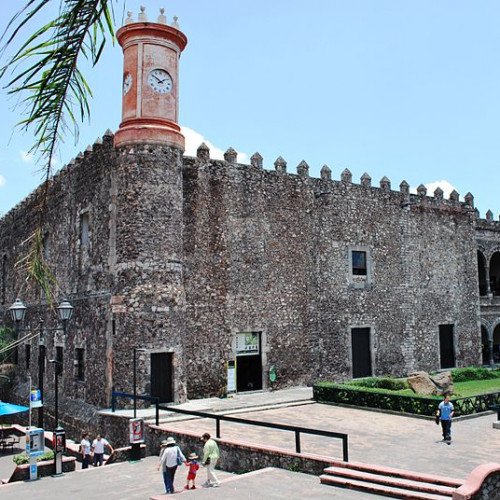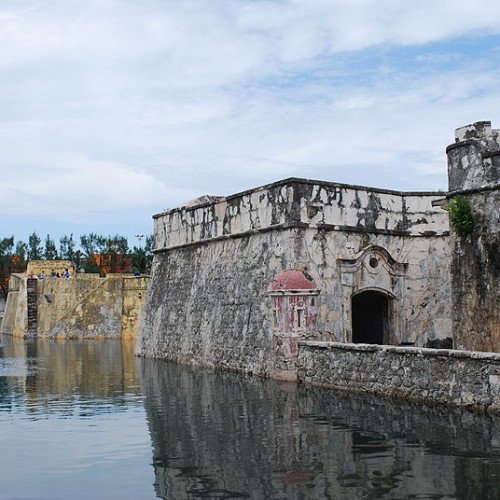Castles of "Mexico" PALACE OF CORTÉS vs SAN JUAN DE ULÚA

PALACE OF CORTÉS
The Palace of Cortés (Spanish: Palacio de Cortés) in Cuernavaca, Mexico, built between 1523-1528, is the oldest conserved colonial-era civil structure in the continental Americas. The architecture is a blend between Gothic and Mudéjar, typical of the early 16th century colonial architecture. The building began as a fortified residence for conqueror Hernán Cortés and his aristocratic second wife, Doña Juana Zúñiga. It was built in 1526, over a Tlahuica Aztec tribute collection center, which was destroyed by the Spanish during the Conquest. Cortés replaced it with a personal residence to assert authority over the newly conquered peoples. As Cortés's residence, it reached its height in the 1530s, but the family eventually abandoned it due to on-going legal troubles. In the 18th century, colonial authorities had the structure renovated and used it as a barracks and jail. During the Mexican War of Independence, it held prisoners such as José María Morelos y Pavón. After the war, it became the seat of government for the state of Morelos until the late 20th century, when the state government moved out and the structure was renovated and converted into the current Museo Regional Cuauhnahuac, or regional museum, with exhibits on the history of Morelos. On the site of this palace a tribute gathering place originally stood, first for Tlahuican rulers, then (after they conquered what is now Morelos in the 15th century) for the Aztecs. In 1526, shortly after the Spanish conquest of the Aztec Empire, the conquistador Hernando Cortés had the pre-Hispanic building destroyed and a palace for himself built in its place. Cortés had chosen Cuernavaca for this residence because of the fertility of the lands surrounding it. Much smaller than the building today (the central part of the extant structure, marked by the use of arches on the balconies, corresponds to Cortés's construction), the original palacio was erected as a fortress, with thick walls, merlons, and other defensive elements, and held its own armory stocked with arquebusses, muskets, cannon, and other weapons. Nevertheless, most of the building was to serve as a residence, supported by mill, stables, gardens, ovens, and more. The main body of the palace was erected with two galleries on the west side containing four arches in each of its two levels; living quarters were built on the north and south sides. A watchtower was added when Cortés was named the Captain General and Governor of New Spain . Befitting the conqueror of Mexico and the Marquess of the Valley of Oaxaca, Cortés had his residence furnished and decorated richly; the walls were covered with twenty one tapestries, the chapel contained crosses and other religious items in gold and silver.
Statistics for this Xoptio

SAN JUAN DE ULÚA
San Juan de Ulúa, also known as Castle of San Juan de Ulúa, is a large complex of fortresses, prisons and one former palace on an island of the same name in the Gulf of Mexico overlooking the seaport of Veracruz, Mexico. Juan de Grijalva's 1518 expedition named the island. On Easter Sunday 1519, Hernan Cortés met with Tendile and Pitalpitoque, emissaries from Moctezuma II's Aztec Empire. It was built between 1535 and 1769. There is a local museum of the fortress, inaugurated in 1984. The fort was constructed during the period of Spanish colonial rule, with construction being initiated in 1535 by the Spanish authorities. The boundaries of the fort were repeatedly expanded several times during its existence. In 1568, the Spanish forces stationed on the fortress succeeded in trapping a privateer fleet under the command of John Hawkins in the fortress's harbour. The commanders under Hawkins included his cousin, the young Francis Drake. Although Hawkins and Drake both managed to escape the organized entrapment on their respective warships, many of the trapped sailors aboard the ships were killed by Spanish cannon fire. Several of the privateer warships present were sunk, and several more were damaged beyond repair, and scuttled along the Mexican coastline. The shipwrecked sailors were abandoned by Hawkins, who chose to cut his losses and venture elsewhere on the Spanish Main. Trapped, and with no rescue in sight, these sailors ventured further inland, where they eventually settled among the local population and integrated into the Mexican populace at large, becoming part of the European diaspora in Mexico. Hawkins, along with Drake, continued his attacks on Spanish shipping transporting valuable cargo such as gold and silver from Spanish colonies in Latin America to Spain. The attack by the Spaniards at San Juan de Ulúa is credited as marking Drake's first feelings of intense hatred of both Catholicism and the Spanish, which would both go on to have an influence on his later career. After the repulse of the privateers, the fortress saw no further action under Spanish control, becoming an isolated outpost of the Spanish Army in New Spain. It saw no action during the Mexican War of Independence, being too far away from the main areas of fighting to see any real action.